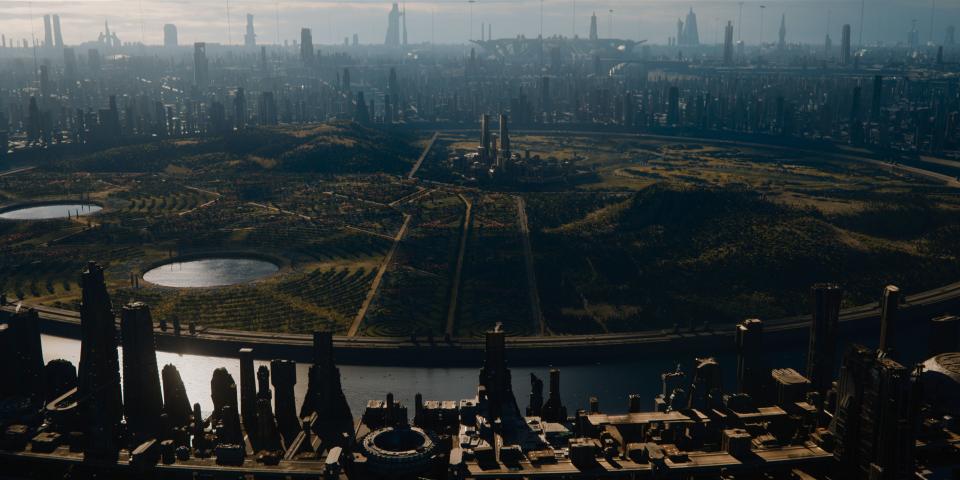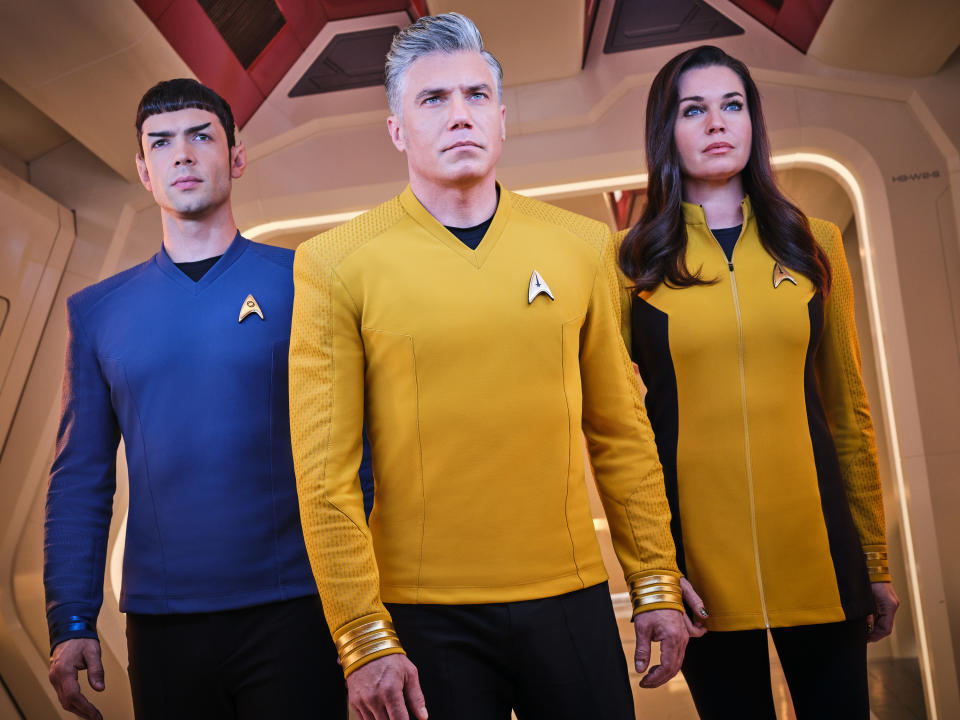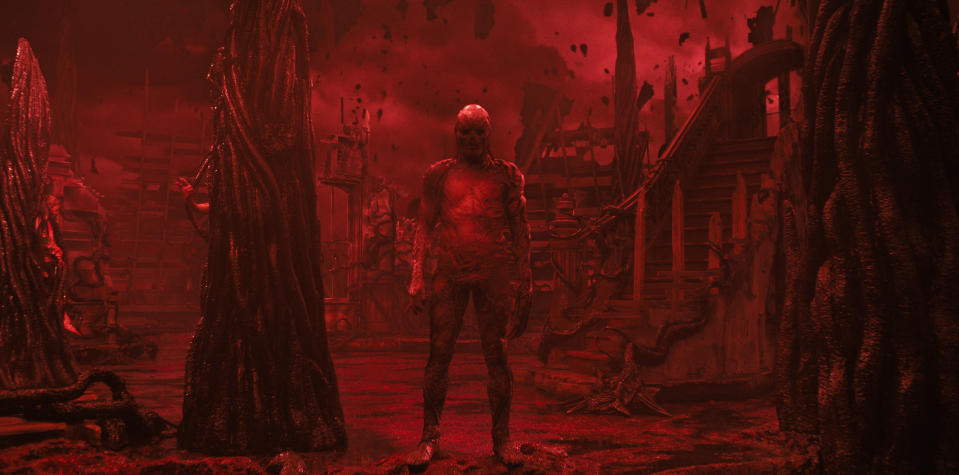Craft Emmy Analysis: 4 Big Questions About the Sci-Fi Contenders

- Oops!Something went wrong.Please try again later.
- Oops!Something went wrong.Please try again later.
- Oops!Something went wrong.Please try again later.
- Oops!Something went wrong.Please try again later.
- Oops!Something went wrong.Please try again later.
[Editor’s Note: This is the second of two parts analyzing the sci-fi craft contenders. Click here to read part one.]
It’s been a great season for large-scale, character-driven, socially relevant sci-fi dramas: Marvel/Disney+’s time-jumping “Loki” and mind-bending “Moon Knight;” Isaac Asimov’s legendary “Foundation” (Apple TV+); the sequel to Nicolas Roeg’s cult classic, “The Man Who Fell to Earth” (Showtime); the latest Star Trek” and “Star Wars” spin-offs, “Strange New Worlds” (Paramount+) and “The Book of Boba Fett” (Lucasfilm/Disney+); and the return of the blockbuster “Stranger Things” (Netflix).
More from IndieWire
'Obi-Wan Kenobi' Episode 5 Highlights Darth Vader's Greatest Weakness
'Arcane': How the Netflix Animated Series Transcended Its Video Game Origin as an Innovator
But as you break the shows down in terms of their Emmy crafts potential and how they stack up against one other, four big questions emerge:

Marvel
1. Can “Loki” and “Moon Knight” Pull a “WandaVision”?
What they offer: After the wild retro TV antics of “WandaVision,” Marvel followed up this season with two trippier shows: “Loki,” in which the titular Norse God of Mischief (Tom Hiddleston) teamed up with detective Mobius (Owen Wilson) to capture dangerous time criminals, and “Moon Knight,” in which Oscar Isaac battled Oscar Isaac in the dual roles of hardened mercenary Marc Spector/Moon Knight and sensitive museum gift shop worker Steven Grant/Mr. Knight.
“Loki” was wrapped in a retro-future aesthetic best described as “‘Mad Men’ meets ‘Blade Runner,’” while “Moon Knight” offered a confounding rabbit hole of childhood trauma, dissociative identity disorder (DID), and Egyptian mythology. By comparison, “WandaVision” seemed like a walk in the park.
But can a “Loki” and “Moon Knight” team-up equal the impact of “WandaVision” on the Creative Arts Emmys? After all, the limited series racked up an impressive 15 nominations in 2021, even though it was ultimately overshadowed by both “The Queen’s Gambit” and “The Mandalorian” and won only three awards (fantasy/sci-fi costumes, half hour production design, and the original song “Agatha All Along”).
“Loki” has been submitted in 16 categories and “Moon Knight” in 15, covering all crafts between them except main theme song. And aside from the fact that “Loki” is a one-hour series and “Moon Knight” a limited series, the only other areas where they don’t overlap is “Loki” being submitted for period/character hairstyling and “Moon Knight” for contemporary production design.
Best bets: “Loki” production designer Kasra Farahani has the best shot at a nomination for that series. The anachronism of “Brazil” was a major influence on The Time Variance Authority, and the TVA’s floating series of modular workstations were a mashup of two retro looks: the clean, angular American mid-century modernism and the the cold, Brutalist architecture found in Europe and the Soviet Union.
The “Moon Knight” costume design of Meghan Kasperlik (“Mare of Easttown,” “Watchmen”) is the standout there. Kasperlik wrapped the titular superhero’s costume around the symbolism of the Egyptian moon god Khonshu. It’s comprised of a Eurojersey that’s been dyed and 3D printed, and then layered with 803 individual pieces, including mummy bandage wrapping.
Other possibilities: Costume designer Christine Wada could get a nod for dressing down Loki: a drab middle-management uniform — white, buttoned-up shirt, thin brown tie, dust-colored jacket — which he still proceeds to look cool in, thanks to Hiddleston’s performance.
For “Moon Knight,” the cinematography of Gregory Middleton (“Game of Thrones”) and Andrew Droz Palermo (“The Green Knight”) captured the twisted journey of Marc and Steven, with the challenge to convey DID through two distinct POVs. Shooting the much-talked-about psych-ward sequence at the end of Episode 4 — in which Marc and Steven begin to confront their dark past — was the highlight of Palermo’s work. He immediately establishes a sense of surreal disorientation with the roving subjective camera.

Courtesy of Apple
2. Is There Room for Both “Foundation” and “The Man Who Fell to Earth”?
What they offer: “Foundation” and “The Man Who Fell to Earth” are the prestigious sci-fi events of the season, exploring heady issues of apocalyptic doom and finding human connection in turbulent times. But in such a crowded field, are they at risk of cancelling each other out in the dominant crafts?
There’s a lot at stake, especially for Apple with the big-budgeted “Foundation,” the epic saga about mathematician Hari Seldon (Jared Harris) predicting the future collapse of the Galactic Empire and plotting to rebuild the culture over the span of a thousand years with the aid of his protege Gaal (Lou Llobell). Executive producer David S. Goyer calls it a “giant chess match.” Season 1 kicked off with a sprawling narrative and spectacular production values.
Meanwhile, Alex Kurtzman and Jenny Lumet created their own mind-blowing and compelling update of “The Man Who Fell to Earth.” Faraday (Chiwetel Ejiofor) crash lands in New Mexico and picks up where David Bowie’s extraterrestrial Newton (portrayed here by Bill Nighy) left off. But he has to painfully transition into human form to complete his scientific quest: to find Justin Falls (Naomie Harris), a former mathematician whose abandoned fusion theory now holds the key to future survival of his planet — and ours.
“Foundation” has been submitted in 15 craft categories (everything of note but stunt performance) and “The Man Who Fell to Earth” in 11 (all of the main crafts, but contemporary production design and hairstyling).
Best bets: VFX (principally done by DNEG and overall supervised by Chris MacLean) is the best bet for “Foundation,” having already won the VES award this year. Among the highlights are the CG industrial territories, particularly the Brutalist-looking Trantor, the Empire’s headquarters with its multilayered structures, imperial palace, and orbital station. However, the biggest innovation was the sand simulation for conveying the distinctive holographic design of Seldon’s psychohistory algorithm — nicknamed “Sandograms” by MacLean and team.
It’s hard to quantify best bets for “The Man Who Fell to Earth” because its crafts are not flashy. This is not like Kurtzman and Lumet’s work in the “Star Trek” universe (more on which below): It’s visceral but low key, built around a series of exquisite incongruities that bring Faraday and Justin Falls together. Cinematography, production design, editing, score, sound editing and mixing all contribute to this, especially in Episode 1 (“Hallo Spaceboy”), where Faraday struggles to process the jarring sights and sounds that bombard him during his human transformation. But perhaps the offbeat score by Emmy winner Jeff Russo (“Fargo”) will break through, not the least of which for making a gritty musical nod to Bowie.
Other possibilities: Production designer Rory Cheyne devised a series of futuristic designs for the planets of “Foundation,” including Trantor and Terminus. For Trantor, he came up with the idea of Brutalism and the multi-layered structures resembling Berlin (where some “Foundation” exteriors where shot). Termimus, which was shot in Iceland and the Canary Islands, was based on the idea of scavenged parts and used shipping containers as structures.
“Foundation” costume designer Eimer Ní Mhaoldomhnaigh, who is new to sci-fi, approached each wardrobe with the same characteristics of period clothing: the multi-layered golden garb for Brother Dusk (Terrence Mann) was a Renaissance riff on the Vatican; Phara’s (Kubbra Sait) bronze suit of armor resembles bark with the help of 3D etched leather; the White-Robed Woman’s (Clare Agius) romantic costume has an ethereal quality.
Sound editing and mixing are other possibilities for for “The Man Who Fell to Earth,” thanks to the subjective soundscape they create for Faraday’s confusion in Episode 1: the effect of the detail and distortion in the way he processes information helps convey a total sense of chaos.

CBS
3. Can “The Book of Boba Fett” and “Strange New Worlds” Leverage Franchise Prestige?
What they offer: The “Star Wars” and “Star Trek” franchises are flourishing for Disney+ and Paramount+, respectively. But can the “Boba Fett” and “Strange New Worlds” spin-offs step out of the shadows of “The Mandalorian” and “Discovery” and gain their own craft recognition? After all, “The Mandalorian” has won 14 craft Emmys, while “Discovery” has nabbed 10 craft nominations and two wins (visual effects in a single episode and prosthetic makeup).
Both shows explore popular characters as first-time protagonists: badass bounty hunter Boba Fett (Temuera Morrison), after appearing briefly in “The Mandalorian,” rises to become the leader of the galactic underworld once controlled by the ruthless Jabba the Hutt; and Captain Pike (Anson Mount), after serving a brief stint on “Discovery,” launches the maiden voyage of the Enterprise prior to Captain Kirk’s legendary exploits.
For “Boba Fett,” creator Jon Favreau took inspiration from “The Godfather” in transforming the former bounty hunter into the new crime lord on Tatooine, whose aim is to achieve tribal solidarity. Season 1 also dovetails with “The Mandalorian,” when Grogu gets trained by Luke Skywalker (Mark Hamill and Graham Hamilton) in the ways of the Force. The spin-off offers shift in tone and a new visual look, bolstered by ILM’s Emmy-winning StageCraft volume platform from “The Mandalorian.”
With “Strange New Worlds,” creators Akiva Goldsmith, Kurtzman, Lumet tell the Enterprise origin story with Pike, who is traumatized by the revelation of his impending death, working alongside Spock (Ethan Peck) and Number One (Rebecca Romijn). As with “Discovery,” the creators continue to make the franchise relevant with diversity while the crafts people modernize the retro vibe of The Original Series.
“Boba Fett” has been submitted in 14 categories (but not music supervision or main title theme music), and “Strange New Worlds” in 13 (no music supervision, stunt coordination, or stunt performance).
Best bets: “The Mandalorian” has found Emmy success with cinematography, production design, VFX, stunts, prosthetic makeup, Ludwig Göransson’s score, and sound mixing. Look for “Boba Fett” to score nominations in most of the crafts, but ILM’s VFX (under the overall supervision of Richard Bluff) is the best bet for a win. ILM continued to excel at its StageCraft sequences (especially Mando’s elevator ride), Mando’s trip to a ring-shaped space station (the Ringworld Megastructure), a host of character work (the Tatooine sand ape, the animatronic Rancor, the BD droid, and the pit droids), and the improved de-aging of Luke Skywalker (ILM would shoot performance actor Graham Hamilton on set with Hamill giving instructions and they would apply their deepfake technique along with other CG facial capture tech as a composite performance).
“Strange New World’s” best bet is prosthetic makeup. Along with some new alien designs, the main challenge for Chris Bridges, the head of prosthetics, was transitioning Spock from his rugged look on “Discovery” to the more polished and iconic Vulcan science officer. He achieved this with tweaks to the ears, eye brows, side burns, hair cut, and skin color.
Other possibilities: “Boba Fett” could also do well in production design and costumes. Production designers Andrew Jones (Emmy winner for “The Mandalorian”) and Doug Chiang expanded the world building by revealing Mos Espa, Tatooine’s largest city, and the high class Sanctuary cantina run by Garsa Fwip (Jennifer Beals), as well as offering more Mandalorian culture. Meanwhile, costume designer Shawna Trpcic went for an appropriately circa-1977 vibe and used real embroidery and fabric treatments, lots of raw silks and cotton. Among her highlights: the inhabitants of the Sanctuary.
“Strange New Worlds” could also prosper in production design, costumes, and VFX. Production designer Jonathan Lee paid attention to the canon aesthetic while adding the scope that’s expected of contemporary TV. The Enterprise bridge retains the influential layout and design of “The Original Series” while using new materials to update its look. Costume designer Bernadette Croft, who worked as an assistant on “Discovery,” carried over the grounding of that series and combined it with the colorful, ’60s flair of TOS. The new uniforms have strong-shouldered silhouettes, shoulder pads, an angular design with the occasional v-neck, and miniskirts. Meanwhile, Jason Zimmerman, the production VFX supervisor, leverages the AR wall virtual set tech of Pixomondo from Season 4 of “Discovery” to create the engineering world of the Enterprise, and some of the alien worlds.

Netflix
4. Can “Stranger Things” Win with Vecna?
What it offers: More popular than ever, “Stranger Things” has amassed 25 craft nominations over its run, but has only won seven Emmys (three for sound editing, and one each for editing, main title design, main title theme music, and casting). Which means there’s a lot of room for improvement. Trouble is, it’s only won for sound editing its last two seasons.
Best bets: Look for “Stranger Things” to continue getting nominated for editing, sound editing and mixing, visual effects, music supervision, and stunt coordination. The question is: Can it finally break through with a visual effects win? Its latest supernatural threat, Vecna, faces tough competition from “Foundation” — but this hybrid of prosthetics and CG is also the series’ best creature work to date.
Other possibilities: Season 4 could also see renewed interest in the world building, with production designer Chris Trujillo back in serious contention for the first time since Season 1. Vecna’s mind lair is an ambitious addition to the Upside Down, wrapping the site of an infamous Hawkins tragedy in the deep reds and ever-present vines of the alternate dimension.
Best of IndieWire
Emmy Predictions: Outstanding Documentary or Nonfiction Special
Emmy Predictions: Outstanding Documentary or Nonfiction Series
Sign up for Indiewire's Newsletter. For the latest news, follow us on Facebook, Twitter, and Instagram.


